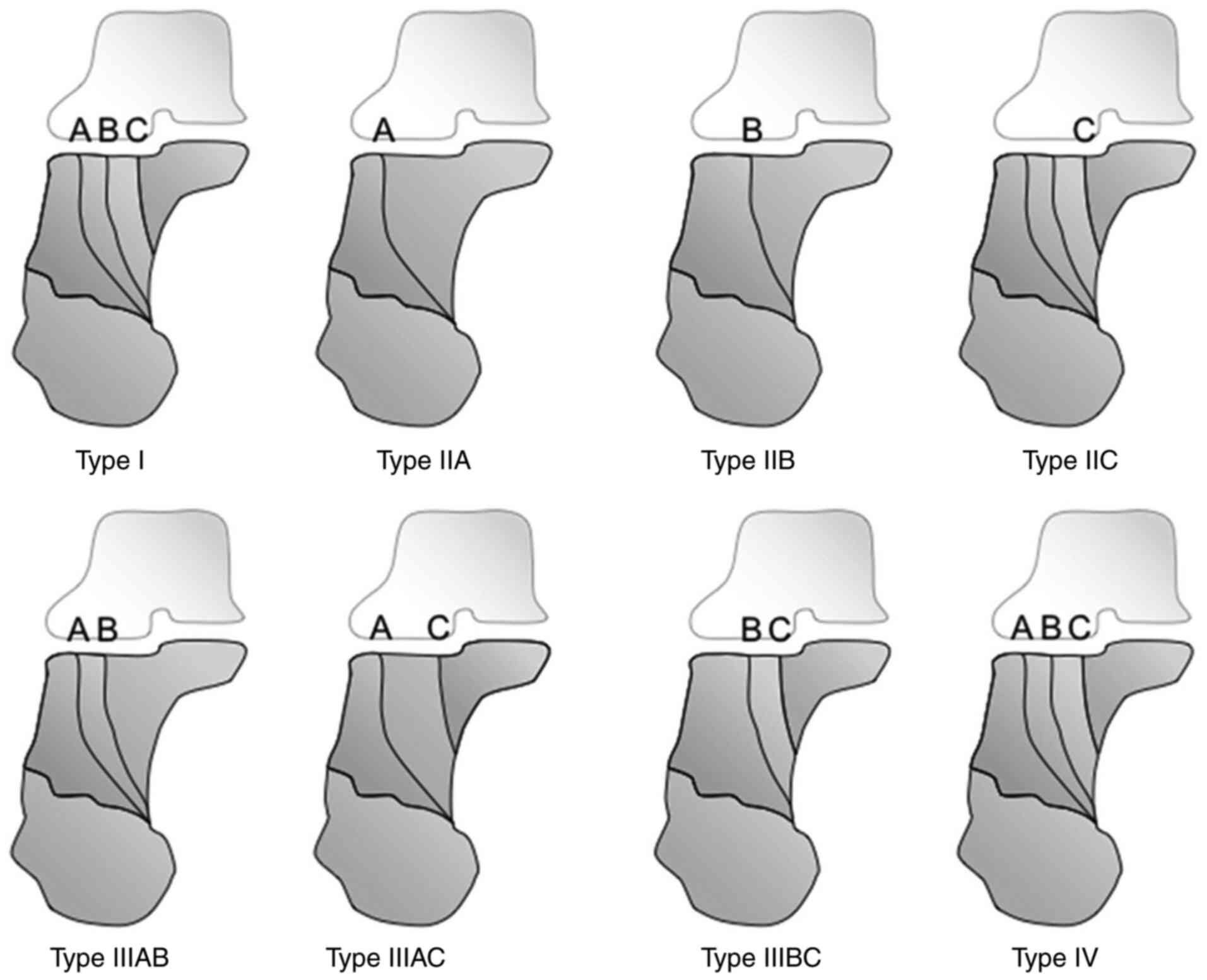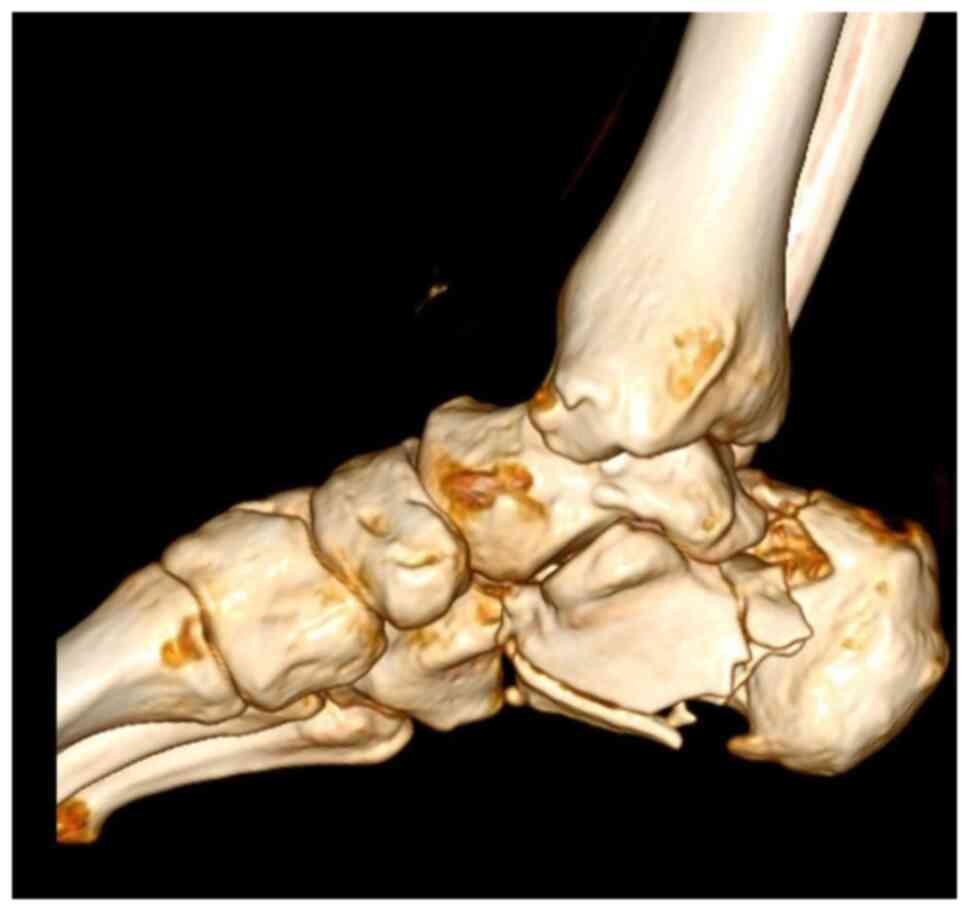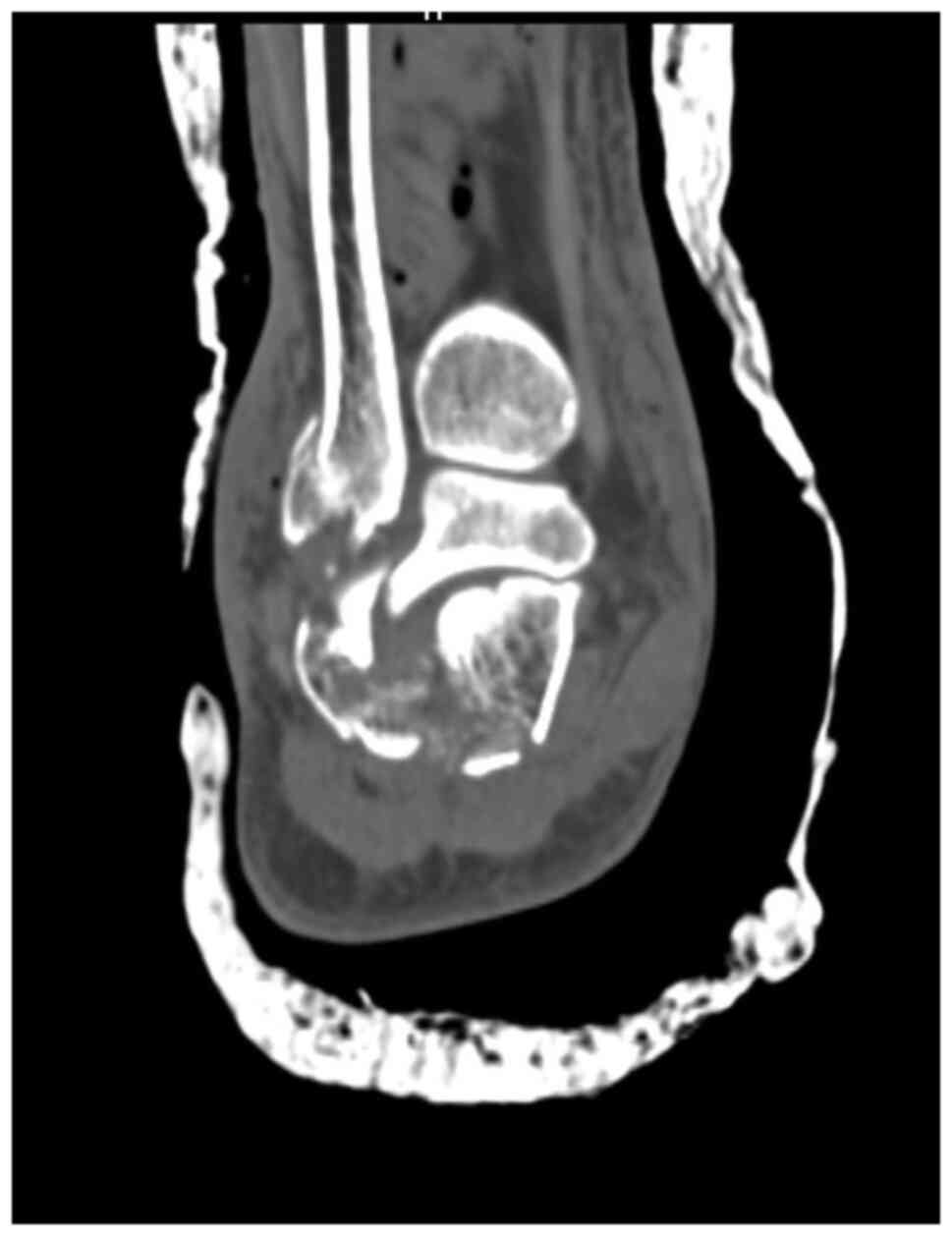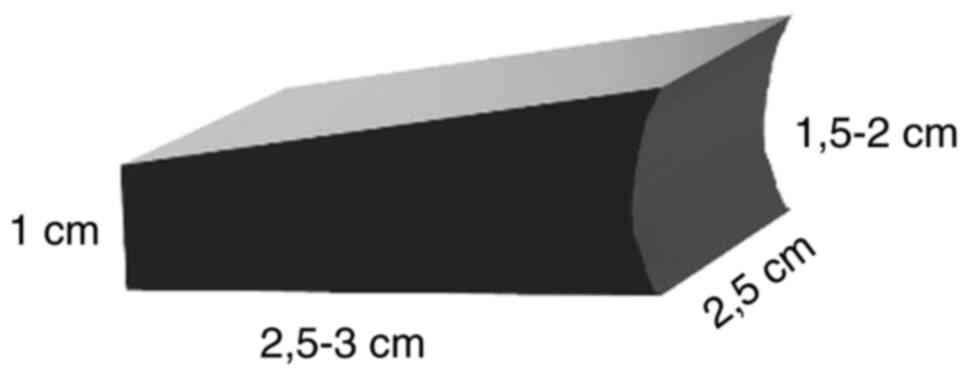|
1
|
Schepers T, van Lieshout EM, van Ginhoven
TM, Heetveld MJ and Patka P: Current concepts in the treatment of
intra-articular calcaneal fractures: Results of a nationwide
survey. Int Orthop. 32:711–715. 2008.PubMed/NCBI View Article : Google Scholar
|
|
2
|
Atkins RM, Allen PE and Livingstone JA:
Demographic features of intra-articular fractures of the calcaneum.
Foot Ankle Surg. 7:77–84. 2001.
|
|
3
|
Soeur R and Remy R: Fractures of the
calcaneus with displacement of the thalamic portion. J Bone Joint
Surg Br. 57:413–421. 1975.PubMed/NCBI
|
|
4
|
Slatis P, Kiviluoto O, Santavirta S and
Laasonen EM: Fractures of the calcaneum. J Trauma. 19:939–943.
1979.PubMed/NCBI View Article : Google Scholar
|
|
5
|
Buckley R, Tough S, McCormack R, Pate G,
Leighton R, Petrie D and Galpin R: Operative compared with
nonoperative treatment of displaced intra-articular calcaneal
fractures: A prospective, randomized, controlled multicenter trial.
J Bone Joint Surg Am. 84:1733–1744. 2002.PubMed/NCBI View Article : Google Scholar
|
|
6
|
Essex-Lopresti P: The mechanism, reduction
technique, and results in fractures of the os calcis. Br J Surg.
39:395–419. 1952.PubMed/NCBI View Article : Google Scholar
|
|
7
|
Rak V, Ira D and Masek M: Operative
treatment of intra-articular calcaneal fractures with calcaneal
plates and its complications. Indian J Orthop. 43:271–280.
2009.PubMed/NCBI View Article : Google Scholar
|
|
8
|
Bajammal S, Tornetta P III, Sanders D and
Bhandari M: Displaced intra-articular calcaneal fractures. J Orthop
Trauma. 19:360–364. 2005.PubMed/NCBI
|
|
9
|
Brauer CA, Manns BJ, Ko M, Donaldson C and
Buckley R: An economic evaluation of operative compared with
nonoperative management of displaced intra-articular calcaneal
fractures. J Bone Joint Surg Am. 87:2741–2749. 2005.PubMed/NCBI View Article : Google Scholar
|
|
10
|
Pozo JL, Kirwan EO and Jackson AM: The
long-term results of conservative management of severely displaced
fractures of the calcaneus. J Bone Joint Surg Br. 66:386–390.
1984.PubMed/NCBI View Article : Google Scholar
|
|
11
|
Stark JG: Use of selective estrogen
receptor modulator for joint fusion and other healing of connective
tissue. US Patent 8,501,690 B2, Filed April 30, 2010; issued August
6, 2013.
|
|
12
|
Liu C, Wan P, Tan LL, Wang K and Yang K:
Preclinical investigation of an innovative magnesium-based bone
graft substitute for potential orthopaedic applications. J Orthop
Translat. 2:139–148. 2014.
|
|
13
|
Calori GM, Mazza E, Colombo M and
Ripamonti C: The use of bone-graft substitutes in large bone
defects: Any specific needs? Injury. 42 (Suppl 2):S56–S63.
2011.PubMed/NCBI View Article : Google Scholar
|
|
14
|
Van der Stok J, Van Lieshout EM,
El-Massoudi Y, Van Kralingen GH and Patka P: Bone substitutes in
the Netherlands-a systematic literature review. Acta Biomater.
7:739–750. 2011.PubMed/NCBI View Article : Google Scholar
|
|
15
|
Almaiman M, Al-Bargi HH and Manson P:
Complication of anterior iliac bone graft harvesting in 372 adult
patients from May 2006 to May 2011 and a literature review.
Craniomaxillofac Trauma Reconstr. 6:257–266. 2013.PubMed/NCBI View Article : Google Scholar
|
|
16
|
Böstman O and Pihlajamäki H: Clinical
biocompatibility of biodegradable orthopaedic implants for internal
fixation: A review. Biomaterials. 21:2615–2621. 2000.PubMed/NCBI View Article : Google Scholar
|
|
17
|
Auer JA, Rechenberg BV, Bohner M and
Hofmann-Amtenbrink M: Bone grafts and bone replacements. Equine
Surg. 2012:1081–1096. 2012.
|
|
18
|
Dias AG, Lopes MA, Gibson IR and Santos
JD: In vitro degradation studies of calcium phosphate glass
ceramics prepared by controlled crystallization. J Non Cryst
Solids. 330:81–89. 2003.
|
|
19
|
Kim HM: Ceramic bioactivity and related
biomimetic strategy. Curr Opin Solid State Materials Sci.
7:289–299. 2003.
|
|
20
|
Giannoudis PV, Dinopoulos H and Tsiridis
E: Bone substitutes: An update. Injury. 36 (Suppl 3):S20–S27.
2005.PubMed/NCBI View Article : Google Scholar
|
|
21
|
Waizy H, Seitz JM, Reifenrath J, Weizbauer
A, Bach FW, Meyer-Lindenberg A, Denkena B and Windhagen H:
Biodegradable magnesium implants for orthopedic applications. J
Mater Sci. 48:39–50. 2013.
|
|
22
|
Seal CK, Vince K and Hodgson MA:
Biodegradable surgical implants based on magnesium alloys-A review
of current research. IOP Conf Ser: Mater Sci Eng: 4, 2009.
|
|
23
|
Su Y, Chen W, Zhang T, Wu X, Wu Z and
Zhang Y: Bohler's angle's role in assessing the injury severity and
functional outcome of internal fixation for displaced
intra-articular calcaneal fractures: A retrospective study. BMC
Surg. 13(40)2013.PubMed/NCBI View Article : Google Scholar
|
|
24
|
Sanders R, Fortin P, DiPasquale T and
Walling A: Operative treatment in 120 displaced in-traarticular
calcaneal fractures. Results using a prognostic computed
Tomogra-phy scan classification. Clin Orthop Relat Res. 290:87–95.
1993.PubMed/NCBI
|
|
25
|
Kuhlmann J, Bartsch I, Willbold E,
Schuchardt S, Holz O, Hort N, Höche D, Heineman WR and Witte F:
Fast escape of hydrogen from gas cavities around corroding
magnesium implants. Acta Biomaterialia. 9:8714–8721.
2013.PubMed/NCBI View Article : Google Scholar
|
|
26
|
Lukyanova E, Yu N, Yu AN, Martynenko AN,
Martynenko N and Estrin Y: Features of in vitro and in vivo
behaviour of magnesium alloy WE43. Materials Lett. 215:308–311.
2018.
|
|
27
|
Xiaoting S, Yuanyuan Z, Shufang Z,
Rongfang Z, Rongfa Z, Chen L and Yijia Z: Characteristics of
selenium-containing coatings on WE43 magnesium alloy by micro-arc
oxidation. Mater Lett. 261(126944)2020.
|
|
28
|
Rahim MI, Ullah S and Mueller PP: Advances
and challenges of biodegradable implant materials with a focus on
magnesium-alloys and bacterial infections. Metals. 8(532)2018.
|
|
29
|
Ding Y, Wen C, Hodgson P and Li Y: Effects
of alloying elements on the corrosion behavior and biocompatibility
of biodegradable magnesium alloys: A review. J Mater Chem B.
2:1912–1933. 2014.PubMed/NCBI View Article : Google Scholar
|
|
30
|
Wang H and Shi Z: In vitro biodegradation
behavior of magnesium and magnesium alloy. J Biomed Mater Res Part
B Appl Biomater. 98:203–209. 2011.PubMed/NCBI View Article : Google Scholar
|
|
31
|
Song Y, Shan D, Chen R, Zhang F and Han
EH: Biodegradable behaviors of AZ31 magnesium alloy in simulated
body fluid. Mater Sci Eng C. 29:1039–1045. 2009.
|
|
32
|
Yan T, Tan L, Xiong D, Liu X, Zhang B and
Yang K: Fluoride treatment and in vitro corrosion behavior of an
AZ31B magnesium alloy. Mater Sci Eng C. 30:740–748. 2010.
|
|
33
|
Witte F, Fischer J, Nellesen J, Crostack
HA, Kaese V, Pisch A, Beckmann F and Windhagen H: In vitro and in
vivo corrosion measurements of magnesium alloys. Biomaterials.
27:1013–1018. 2006.PubMed/NCBI View Article : Google Scholar
|
|
34
|
Witte F, Kaese V, Haferkamp H, Switzer E,
Meyer-Lindenberg A, Wirth CJ and Windhagen H: In vivo corrosion of
four magnesium alloys and the associated bone response.
Biomaterials. 26:3557–3563. 2005.PubMed/NCBI View Article : Google Scholar
|
|
35
|
Tan L, Yu X, Wan P and Yang K:
Biodegradable materials for bone repairs: A review. J Mater Sci
Technol. 29:503–513. 2013.
|
|
36
|
Hong D, Saha P, Chou DT, Lee B, Collins
BE, Tan Z, Dong Z and Kumta PN: In vitro degradation and
cytotoxicity response of Mg-4% Zn-0.5% Zr (ZK40) alloy as a
potential biodegradable material. Acta Biomater. 9:8534–8547.
2013.PubMed/NCBI View Article : Google Scholar
|
|
37
|
Gu XN, Li N, Zheng YF and Ruan L: In vitro
degradation performance and biological response of a Mg-Zn-Zr
alloy. Mater Sci Eng B. 176:1778–1784. 2011.
|
|
38
|
Li Z, Gu X, Lou S and Zheng Y: The
development of binary Mg-Ca alloys for use as biodegradable
materials within bone. Biomaterials. 29:1329–1344. 2008.PubMed/NCBI View Article : Google Scholar
|
|
39
|
Zhao C, Pan F, Zhang L, Pan H, Song K and
Tang A: Microstructure, mechanical properties, bio-corrosion
properties and cytotoxicity of as-extruded Mg-Sr alloys. Mater Sci
Eng C Mater Biol Appl. 70:1081–1088. 2017.PubMed/NCBI View Article : Google Scholar
|
|
40
|
Kannan MB: Influence of microstructure on
the in-vitro degradation behaviour of magnesium alloys. Mater Lett.
64:739–742. 2010.
|
|
41
|
Zhang S, Zhang X, Zhao C, Li J, Song Y,
Xie C, Tao H, Zhang Y, He Y, Jiang Y and Bian Y: Research on an
Mg-Zn alloy as a degradable biomaterial. Acta Biomater. 6:626–640.
2010.PubMed/NCBI View Article : Google Scholar
|
|
42
|
Liu C, He P, Wan P, Li M, Wang K, Tan L,
Zhang Y and Yang K: The in vitro biocompatibility and macrophage
phagocytosis of Mg17Al12 phase in Mg-Al-Zn alloys. J Biomed Mater
Res A. 103:2405–2415. 2015.PubMed/NCBI View Article : Google Scholar
|
|
43
|
Gao L, Chen RS and Han EH: Solid solution
strengthening behaviors in binary Mg-Y single phase alloys. J
Alloys Compd. 472:234–240. 2009.
|
|
44
|
Yang H, Liu C, Wan P, Tan L and Yang K:
Study of second phase in bioabsorbable magnesium alloys: Phase
stability evaluation via Dmol3 calculation. APL
Materials: Nov 8, 2013 (Epub ahead of print) doi:
org/10.1063/1.4828935.
|
|
45
|
Zhang X, Zhang K, Li X, Deng X, LI Y, Ma M
and Shi Y: Effect of solid-solution treatment on corrosion and
electrochemical behaviors of Mg-15Y alloy in 3.5 wt.% NaCl
solution. J Rare Earths. 30:1158–1167. 2012.
|
|
46
|
Südholz AD, Kirkland NT, Buchheit RG and
Birbilis N: Electrochemical properties of intermetallic phases and
common impurity elements in magnesium alloys. Electrochem Solid St
Lett. 14(C57)2011.
|
|
47
|
Hofstetter J, Martinelli E, Pogatscher S,
Schmutz P, Povoden-Karadeniz E, Weinberg AM, Uggowitzer PJ and
Löffler JF: Influence of trace impurities on the in vitro and in
vivo degradation of biodegradable Mg-5Zn-0.3Ca alloys. Acta
Biomater. 23:347–353. 2015.PubMed/NCBI View Article : Google Scholar
|
|
48
|
Crawford T, Rodvold KA and Solomkin JS:
Vancomycin for surgical prophylaxis? Clin Infect Dis. 54:1474–1479.
2012.PubMed/NCBI View Article : Google Scholar
|
|
49
|
Chen L, Peng W, Li LT, Kehong W and Ke Y:
Preclinical investigation of an innovative magnesium-based bone
graft substitute for potential orthopaedic applications. J Orthop
Translat. 2:139–148. 2014.
|
|
50
|
Sommar P, Granberg Y, Halle M, Skogh AC,
Lundgren KT and Jansson KÅ: Effects of a formalized collaboration
between plastic and orthopedic surgeons in severe extremity trauma
patients; a retrospective study. J Trauma Manag Outcomes.
9(3)2015.PubMed/NCBI View Article : Google Scholar
|
|
51
|
Buch BD, Myerson MS and Miller SD: Primary
subtalar arthrodesis for the treatment of comminuted calcaneal
fractures. Foot Ankle Int. 17:61–70. 1996.PubMed/NCBI View Article : Google Scholar
|



















